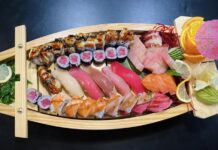As September winds down without necessarily cooling down, a summer jam festival may be the perfect way to beat the heat for a night. The Turn Down the Heat Tour, featuring Fantasia and special guests Jagged Edge and K-ci and JoJo, will be at 7 p.m. Saturday at the OKC Civic Center Music Hall, 201 N. Walker Ave., OKC. Advance tickets are $40-70 – a small price to pay for some cool tunes and acts. For more information, check out www.okcciviccenter.com.
The True Story of the Three Little Pigs
Alexander T. Wolf is on trial for a scandalous housing disaster, but is he as “big” and “bad” as they say, or was he framed? Based on a popular children’s book, this Tulsa Performing Arts Center Trust presentation lets the piglets of the jury (and in the audience) decide at the Tulsa Performing Arts Center, 110 S. Second St., Tulsa. Shows are at 7 p.m. Friday and 11 a.m. Saturday. Tickets are $10, available for purchase at www.myticketoffice.com.
American Moderns, 1910-1960: From O’Keeffe to Rockwell
Discover artists who rejected painting tradition and sought to find new ways of expression in an unfamiliar era. Fifty-seven artworks from the Brooklyn Museum collection go on display at the Oklahoma City Museum of Art, 415 Couch Drive, Oklahoma City, exhibiting the myriad approaches to style, subject and matter from artists including Stuart Davis, Milton Avery, Rockwell Kent and others. Tickets are $12 for adults when the exhibit opens Thursday. The exhibit runs through Jan. 6. www.okcmoa.com
The Go-Go’s
High pop star priestesses from the ‘80s seek to show Tulsa some fun at the Hard Rock Tulsa Hotel & Casino with a show in the Joint at 8 p.m. Thursday. The band’s Ladies Gone Wild Tour breaks out hits like “Vacation” and “We Got the Beat” for $35, $40 and $44. Sorry young’uns – guests must be 21 & over to enter the Joint, 777 W. Cherokee St., Catoosa. Tickets are available at www.hardrockcasinotulsa.com.
WWE Presents
Is there anything more enthralling for the pro wrestling fan than a chance to catch their favorite stars in action? Here’s one way to find out: WWE Presents “Raw” at the Chesapeake Energy Arena, 100 W. Reno Ave., Oklahoma City, at 6:30 p.m. Monday before trucking “Smackdown” to the BOK Center, 200 S. Denver Ave., Tulsa, for a 6 p.m. Tuesday show.
Wrestling superstars past and present pay tribute to Oklahoman WWE Hall of Famer, Jim Ross in OKC, while the showdown for the WWE World Heavyweight Championship takes place in Tulsa. “Raw” tickets start at $15, available at www.chesapeakearena.com, while “Smackdown” prices begin at $17 at www.bokcenter.com.
The 2013 Oklahoma Wedding Show
Are you a bride to be?
Make plans to attend the Oklahoma Wedding Show, Saturday, January 5, 2013 from 10 to 4 at Expo Square Central Park Hall.
Get expert advice from top wedding pros, sample scruptious cakes, enjoy bridal fashion shows, win amazing prizes and much, much more.
Presented by Oklahoma Magazine.
Are you a wedding vendor?
Contact us today to reserve your space for the Oklahoma Wedding Show. A limited number of premium booths spaces are available.
Call 918.744.6205 and ask how you can become part of the best wedding show. Or email us at [email protected] for complete details.
Happy Halloween or Harvest?
In these fall days, humans turn to one fruit more than any other: the pumpkin. Suddenly, they appear en mass at grocery store entrances, roadside stands, in fields and on the dinner table. Whether gutted and carved for a Halloween jack-o-lantern or nestled among other assorted gourds on a hay bale, pumpkins tell us all that its time to take in the outdoors before winter, pick pecans and scare the wits out of all your friends. Pumpkins remind us of cool events like the Halloween Parade in Oklahoma City, Tulsa’s Hex House and the Psycho Path in Sperry just as much as they bring to mind the Pleasant Valley Farms Winter Squash and Pumpkin Festival in Sand Springs, Tulsa Oktoberfest and the Pumpkin Festival at Shepherd’s Cross near Claremore. Wherever you end up, there’s sure to be a pumpkin watching from nearby. See the community and family listings for events details and more Halloween and harvest fest fun.
Earth Energy
Sunrise Alternative Energy has designed and installed geothermal heating and air conditioning systems for more than 25 years now. “One of the biggest misconceptions about geothermal is that it is a new technology,” says Bob Willis, owner of the Edmond, Okla.-based company. And this efficient alternative energy source is not just for new construction. “We retrofit geothermal into many existing homes,” adds Willis.
Geothermal heat pumps, also referred to as ground source heat pumps (GSHPs) are similar to ordinary heat pumps, but instead of using heat found in outside air, the system relies on the free energy of “the greatest solar collector in existence,” the earth, to provide heating, air conditioning and even hot water. Even though summers can be blazing hot and winters frigid, at six feet underground temperatures typically range from a stable 45 to 75 degrees.
In winter, natural heat from the earth is collected as fluid circulates through a series of underground pipes, called a loop. Then, using an electrically driven compressor and a heat exchanger, the heat is released inside the home. During the summer, the loop draws excess heat from the house where it is absorbed into the earth.
“Geothermal reduces electricity use, shifts high use to off-peak loads and creates American jobs. It’s a win-win-win,” explains Willis. Approximately 70 percent of the energy used in a geothermal heat pump system is renewable energy from the ground.
Geothermal systems can be installed in virtually any size residence and on almost any size lot, with pipes under lawns, driveways and even the house. Underground horizontal loops, the most common and cost efficient system, are used when the size of the lot is large enough. If the yard is too small or the soil is too rocky, a vertical loop plunging several hundred feet deep is utilized.
Initially installing a geothermal HVAC system is expensive, but consumers can expect at least 30 to 40 percent lower energy bills, according to estimates from the U.S. Environmental Protection Agency, who also includes geothermal heat pumps in the EnergyStar program. The systems are rated to last around 25 years.
“Geothermal is approximately 30 percent more up-front than a conventional system, but after the 30 percent federal tax credit and various available rebates, the initial cost is paid back fairly soon,” says Willis. Check the Database of State Incentives for Renewables and Efficiency (www.dsireusa.org) for the list of rebates and tax credits available throughout Oklahoma.
Oklahoma happens to be the epicenter of geothermal research and development since the International Ground Source Heat Pump Association (IGSHPA) World Headquarters is located on the Oklahoma State University campus in Stillwater.
Geothermal heat pump systems are usually not do-it-yourself projects. You’ll want the professional expertise from an accredited installer familiar with IGSHPA procedures to calculate a home’s heat load and design a system based upon various factors including soil condition, lot size and the home’s overall square footage. Retrofit projects typically can utilize current ductwork while new construction installations should be coordinated with the builder.
Eight years after Willis installed a geothermal system in Edmond homeowner Veta Roberts’ spacious, five-bedroom home, she continues to be thrilled with the results. “It’s quiet, low maintenance, and our monthly utility bill is considerably less than if we had conventional heat and air conditioning,” she says.
Here Comes The Sun
This month, lucky children all over Oklahoma are off to the pumpkin patch where they’ll pick the best of this year’s harvest with one end in mind: the mighty jack o’ lantern. A few industrious kids might go so far as to smash the filling to make pies, but most of the pumpkins will simply end up shriveled on the threshold by the month’s end – their once-ghoulish grins sagging.
Worst-case scenario, the pumpkin will actually get pushed off the steps into the flowerbed where it will, in the spring, create a wild pumpkin vine, something I know all too well about from personal experience.
To be honest, I’d like to avoid this whole situation but the reality is my daughter, now 3, is finally getting to the age when she can scoop with real enthusiasm. My plan is to put my pumpkin to good use with a bright, sunny breakfast treat from Malawi, in southern Africa, called Mbatata. These beautiful, sunrise-colored biscuits are traditionally made with sweet potato, although pumpkin strikes me as the perfect seasonal variation.
Malawi is affectionately called the Heart of Africa because of the warmth and friendliness of her people. Similarly, these biscuits have been the happy heart of my breakfast table since I first tried them last winter. When served straight from the oven, split and spread with softened pats of butter, this is about as moist and tender as biscuits get.
Don’t even get me started on the fact that sweet potatoes and pumpkins are healthy. It’s just a win-win when you put them in biscuit form.
Sunrise Biscuits
4 tbsp. salted butter
1/3 c. milk
3/4 c. baked, mashed sweet potato or pumpkin
Pinch ginger
1/4 tsp. salt
1 1/3 c. flour
2 tsp. baking powder
Preheat the oven to 375 degrees and line a baking pan. Roast the sweet potatoes or pumpkin until soft; be sure to slit sweet potatoes with a knife so they don’t burst. This can take up to an hour. Reduce the heat to 350 degrees. While the sweet potatoes or pumpkin are still very hot, add 3/4 cup to a bowl with the cubed butter. Allow the heat of the sweet potatoes or pumpkin to melt the butter; if you’re making this with cold, leftover sweet potatoes or pumpkin, melt the butter before combining the two ingredients. Add the milk, pinch of ginger and salt. Stir in the flour and baking powder. The salmon-colored dough will be very moist.
On a heavily floured board, with heavily floured hands, press the dough flat, about one inch thick. Dip a cookie cutter into flour to keep the biscuit dough from sticking, then cut biscuits out of the rolled out dough. Lay the biscuits on a lined baking sheet. Bake for 15-20 minutes, or until puffed and golden, just like the glimmer of the perfect sunrise. Enjoy with a softened pat of butter. Makes roughly eight biscuits.
Recipe adapted from World Cookbook for Students.
The Pour
Oklahoma weather tempts us with crisp fall-like days in September, but generally it’s October when autumn gets started in earnest. With this change, thoughts turn to classic seasonal flavors and warming comfort foods and drinks. Ryan Stack, bar manager at Juniper Restaurant & Martini Lounge, has seen this play out with customers at his bar. He says the sweltering summer weather had everyone reaching for light chardonnays and rosés, refreshing cocktails made with sparkling wine and fruit juices and ice-cold summer brews. Now customers have a taste for familiar earthy flavors suitable for fall.
Stack says that as Juniper developed the fall menu they’ve kept libations in mind, tailoring their famous infused spirits to match the season. A clear winner is the apple cinnamon bourbon – Bulleit infused with Granny Smith apples and fresh ground cinnamon – that is used to create a Manhattan that pairs perfectly with heartier fare such as pork belly and duck.
“It’s a twist on a classic that reminds people of the best parts of the fall,” says Stack.
Apple Cinnamon Manhattan
3 oz. apple cinnamon infused Bulleit bourbon*
1/2 oz. Formula Antiqua Sweet Vermouth.
Shake with ice and strain into a chilled martini glass. Garnish with a cherry.
*If you’d like to experiment with making your own infused liquor, a number of good tutorials are available online.






















